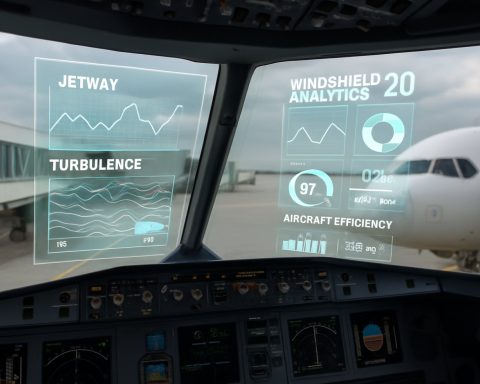- Nvidia’s stock has dropped over 25% from its peak, presenting a potential investment opportunity for savvy investors.
- The company’s current valuation suggests it is undervalued, with a forward P/E ratio of 24.5 and PEG ratio under 0.5.
- Nvidia has shown remarkable revenue growth, with a 383% increase over two years, and forecasts significant growth in the coming years.
- Dominance in the GPU market positions Nvidia as a leader in AI, with its CUDA platform offering a technological edge over competitors.
- Nvidia’s hardware plays a crucial role in the surge of AI infrastructure, with significant investments from companies like Meta and OpenAI.
- The estimation of $1 trillion AI data center spending by 2028 hints at substantial future gains for investors.
- Nvidia’s leadership in the AI sector suggests that betting against it could mean missing significant growth potential.
A ripe opportunity often hides behind the shadows of market turmoil. As the stock market stays on a volatile roller coaster, even robust titans like Nvidia find themselves caught in the turbulence. This tech behemoth has seen its stock plummet over 25% from its peak, sparking conversations about potential value beneath the surface. For savvy investors, Nvidia’s recent dip might just be the diamond in the rough.
Viewed through the lens of growth and potential, Nvidia doesn’t just stand as a giant in its field—it is a phoenix destined for resurgence. The current valuation paints an attractive picture; a forward price-to-earnings ratio of 24.5 and a PEG ratio under 0.5 signify a stock that’s priced below its inherent promise. This is no small feat for a company whose revenue has ballooned by an eye-popping 383% over the past two fiscal years, projecting further leaps of 54% in 2025 and nearly 24% in 2026.
Beyond mere numbers lies Nvidia’s undisputed dominance in the graphics processing unit (GPU) arena. Once a tool for vivid gaming experiences, GPUs have morphed into the bedrock for the data-hungry world of artificial intelligence. Nvidia’s innovative CUDA platform is the crown jewel that sets it miles apart from competitors, allowing adaptability far beyond its original design—a technological atlas guiding through the AI renaissance.
Its closest rival, Advanced Micro Devices, continues to trail years behind, struggling with software hurdles that Nvidia has long surpassed. This technological edge isn’t merely a fluke; it’s testament to a moat as wide as it is deep.
In the crescendo of AI infrastructure spending, Nvidia’s role is akin to that of a maestro in an expanding orchestra. AI model training demands a plethora of GPUs, each more potent than before. Giants like Meta Platforms and fledgling innovators such as xAI endeavor to enhance AI with Nvidia’s cutting-edge hardware. The result is a staggering increase in data center investments. With companies like OpenAI and Softbank planning colossal capital expenditures on AI infrastructure, Nvidia remains a pivotal cog in this grand machinery.
Nvidia foresees an AI data center spend culminating in a staggering $1 trillion by 2028. If its vision aligns with reality, current stockholders might find themselves holding the keys to the AI kingdom, a domain bound to expand rapidly alongside technological breakthroughs.
Investing, at its heart, is about foresight; in Nvidia’s case, the horizon appears not just promising but transformative. As the world marches toward an AI-driven future, betting against such a firmly established leader like Nvidia might just mean missing out on the next big wave that redefines industry standards. For those with the acumen to perceive this opportunity, the potential rewards seem boundless.
Why Nvidia’s Stock Dip Could Be the Perfect Opportunity for Savvy Investors
Understanding Nvidia’s Market Position and Potential
Nvidia’s recent stock decline, over 25% from its peak, offers a fascinating scenario for investors looking to capitalize on market volatility. While this dip might initially seem concerning, a deeper dive into Nvidia’s market position and growth potential reveals a promising opportunity.
Pros and Cons of Investing in Nvidia
Pros:
– Market Leadership in GPUs: Nvidia is a leader in the GPU market, essential for gaming and increasingly critical in the AI and data center sectors.
– Innovative Platforms: The CUDA platform offers a competitive edge, boosting Nvidia’s software adaptability for modern applications.
– Growth Projections: Revenue growth is expected to continue at a robust pace, with predictions showing a 54% increase in 2025 and 24% in 2026.
– AI and Data Center Focus: Nvidia’s investments in AI infrastructure forecast a potential $1 trillion market by 2028, signaling significant future demand for its products.
Cons:
– Market Volatility: The current stock volatility can be daunting for risk-averse investors.
– Strong Competition: While AMD is currently behind, persistent competition could pose future challenges.
– Dependence on AI Growth: Nvidia’s growth relies on the sustained expansion of the AI sector, which, while likely, is not guaranteed.
Emerging Trends in AI and Nvidia’s Role
The AI sector is on an upward trajectory, with substantial investments expected from tech giants like Meta Platforms and innovative newcomers like OpenAI and Softbank. Nvidia stands at the forefront of this movement, providing the critical hardware needed for advanced AI model training. As AI technology continues to evolve, Nvidia’s GPUs serve as a cornerstone for future innovations, ensuring its relevance and demand in the sector.
Real-World Use Cases for Nvidia’s Technology
1. AI Model Training: Nvidia’s GPUs are integral for training complex AI models, speeding up processes that would be otherwise time-consuming and resource-intensive.
2. Virtual Reality and Gaming: Beyond AI, Nvidia’s GPUs continue to revolutionize gaming by providing enhanced graphics and better user experiences.
3. Data Centers: With growing data needs, Nvidia’s technology assists in expanding data center capabilities, supporting cloud computing and big data analytics.
Nvidia vs. Competitors: A Comparative Review
– Nvidia vs. AMD: While AMD is a formidable competitor, Nvidia currently maintains a technological edge, especially in AI-focused adaptations due to its superior software ecosystem.
– Nvidia vs. Intel: Intel is diversifying into the GPU space but lacks Nvidia’s deep-rooted expertise and market dominance.
Actionable Investment Tips
1. Evaluate Valuation Ratios: Nvidia’s current P/E and PEG ratios suggest that the stock may be undervalued relative to its potential growth.
2. Diversify Your Portfolio: While Nvidia offers promising prospects, diversification remains key to managing market volatility risks.
3. Stay Informed on AI Developments: Keep an eye on AI breakthroughs and Nvidia’s role within these advancements to make informed investment decisions.
Conclusion: Is Nvidia a Buy?
Given its strong market position, innovative potential, and pivotal role in the AI industry, Nvidia represents a compelling investment opportunity. Those who recognize Nvidia’s potential stand to benefit from substantial long-term returns, particularly as its AI footprint expands. However, investors should remain vigilant of market trends and be prepared to adapt their strategies as the landscape evolves.
For further reading on Nvidia and market dynamics, visit [Nvidia’s website](https://www.nvidia.com).











